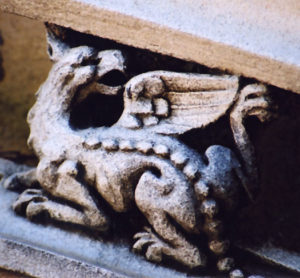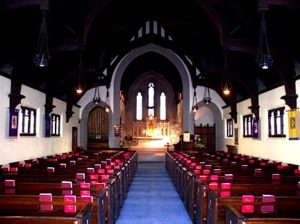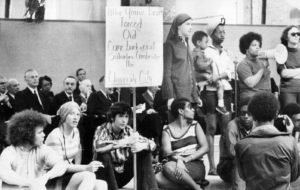SWEDENBORG CHAPEL: Living history
by Ruth Hobeika, 2017
“Planting community” is how the century-old Swedenborg Chapel’s Reverend Sage Cole describes a year-long outreach set to launch in January, joining visions from opposite sides of the country.
Anna Woofenden – currently a visiting consultant – is exploring the question of what it means to be a church today, when so many congregations are dwindling. She is founding pastor of the Garden Church in Los Angeles and its sister nonprofit urban farm (Feed and Be Fed).
Swedenborgians number over 10,000 internationally, heavily concentrated in North America. The chapel at the corner of Quincy and Kirkland Streets is one of only 30-some such “fellowships” now in the U.S. But membership numbers have never reflected the movement’s outsized influence on a long list of thinkers, writers, artists, and public figures since its heyday in the nineteenth and early-twentieth century. (Count FDR and Martin Luther King, Jr., in that number.)
The Cambridge congregation has always provided a haven for spiritual experience in all its many forms, making its space available to “more than just our own,” says Reverend Cole. Now, “together, we’re hoping to set the chapel on a new course to expand its ministry.”
The Place: Cambridge Roots Although the chapel dates to 1901, Cambridge has been a center of Swedenborgian thought since the 1790s. As recently as the 1960s, the block of Harvard buildings flanking the chapel belonged to the Swedenborgian community. The Late Gothic Revival landmark is listed in the National Registry of Historic Places and is officially acknowledged as an architectural and cultural rarity in Massachusetts history, says the Cambridge Historical Commission.
With its half-acre nestled between two Harvard University concrete structures (William James Hall and the Gund Hall School of Design), the tiny gabled stone chapel is surrounded by hand-laid stone walls, abundant gardens, and meandering paths. Just beyond the commotion of Harvard Square, it has the feel of another time.
Its stillness provides a modest buffer for the adjacent mid-Cambridge neighborhood, which welcomes this vestige of open space and peaceful feelings. In 1999, a cadre of devoted neighbors played white knight to help a small band of congregants win landmark protection. That halted a developer’s bid to convert the chapel’s altar space into the atrium of a high-rise condo complex.
Preservationists cite the interior as an unusual example of the nineteenth-century Arts & Crafts Movement style championed by William Morris and Oscar Wilde. The hand-carved pews and altar, wrought iron fixtures, and “Mercer” floor tiles glazed with symbolic motifs reflect artists’ efforts to preserve individualism against the impact of industrialization.
The Principles: Doing things that matter
Swedenborgianism is both a religion and a school of thought. “All religion relates to life, and the life of religion is to do good” is high among the precepts of its founder, Emanuel Swedenborg – eighteenth-century Swedish noble, scientist, economist, and Christian mystic. Buddhist philosopher D.T. Suzuki called him “Buddha of the North.”
Swedenborg wrote over 50 books, touching on topics strikingly modern, such as the interconnectedness of soul and body, and a vision of a spiritual age where religion is not necessarily church-based. After his death, Swedenborg’s followers in England founded the Church of the New Jerusalem.
His thought and scriptural interpretations have been admired internationally and across cultures, especially by spiritual seekers and those interested in reshaping society – from Blake, Baudelaire, and Jung on the continent to Mary Baker Eddy, Margaret Fuller, and Andrew Carnegie here. Also, Johnny Appleseed and Ralph Waldo Emerson.
Locally, the proximity of Harvard University has provided fertile ground for the Swedenborgian intellectual bent. • Swedenborgians from Harvard include William James (“father of American psychology”), Helen Keller, and chapel designer H. Langford Warren (founder of the adjacent school of architecture). • The pastor, Reverend Cole, is among the Harvard Chaplains’ professional community representing world religious, spiritual, and ethical traditions.
Outgrowths
Putting into practice its principles of open-mindedness, personal responsibility, and largess, the chapel hosts weekly activities for many who gravitate there to teach, perform, or talk. And, making the space a nonprofit center for groups to hold events is in the pot of ideas being considered. “We’ll have to see what’s new that’s going to grow,” says Reverend Cole.
• Currently, the chapel’s communal hub encompasses a Korean Methodist congregation and a Nigerian Anglican church that worship on Sundays, plus Cambridge Community Kirtan. The latter, on alternating Wednesday nights, offers a music-making/chanting experience that is open to the public for free or a suggested donation.
• Every Christmas Eve, at 4:30 p.m., scripture is read by candlelight, with carols, and open to the public.
• In February or March, look for Boston Shakespeare Company’s production of Richard III at the chapel.





